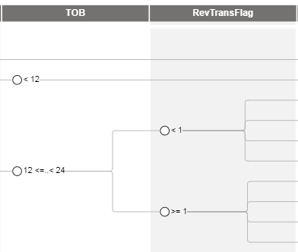Editing Splits
Edit a split for a tree variable/predictor when you want to modify an existing set of branches for a condition node.
Decision tree counts (see
Counting and Recounting Decision Trees for more) are cleared when you modify one or more splits.
- Identify an existing node that you want to edit and select its parent node.

 Note The parent node is the node that contains the values of the decision node you want to edit.
Note The parent node is the node that contains the values of the decision node you want to edit. - Select or select the command from the shortcut menu.
- Complete the appropriate step for the type of decision node you are editing:
Editing Splits for Numeric and String Decision Nodes Decision Node Variable Type Step Numeric variable - Keep the Lower limit inclusive selection or select Upper limit inclusive.
- Add a branch, remove a branch (by clicking X on the right side of a row), group rows, or any combination of these steps.
Caution Removing a branch also deletes its child nodes from the tree. Attempting to revert the deleted branch by re-entering the original value does not recreate the child nodes. You would need to manually recreate the original child nodes in the Tree view canvas.String variable Group, ungroup, or reorder rows. - Click APPLY to save your changes.

|
Note If you assigned target variables when you created your tree, you can use the best-split algorithm to show split results recommended to determine the optimal splits for your tree. See
Determining Best Split with Target-Driven Decision Trees for more information.
|
Key Bindings
If a node is currently selected in the Tree View, then these key bindings are available to select a nearby node. The view content scrolls if necessary so that the newly selected node is visible. This type of navigation can be useful when working with a large decision tree. These key bindings function only in the Tree View.
| Keys | Action/Description |
|---|---|
| Left | Select the parent node of the currently selected node. |
| Right | Select the first child node of the currently selected node. |
| Up | Select the previous sibling node of the currently selected node. |
| Down | Select the next sibling node of the currently selected node. |
| Home | Select the Start node |

